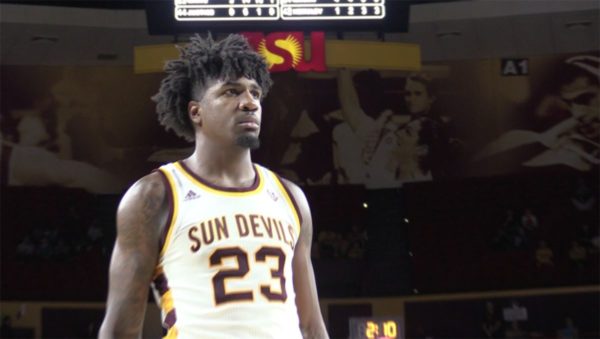Introducing Arizona State’s Frontcourt and the Nationally Ranked Sun Devils
Posted by Adam Butler on December 1st, 2017It’s worth noting that Arizona State is ranked. In men’s basketball. It’s an infrequent Tempe phenomenon but something that’s perhaps not all that shocking. There were glimpses a season ago, however, and the Sun Devils returned a number of critical pieces while adding that which they were missing. And what were they missing? Size. Or at least anyone capable of grabbing a rebound. The Devils ranked 313th and 292nd in defensive and offensive rebounding, respectively, in 2016-17. Sitting on their bench due to NCAA red tape, though, was perhaps the answer. Romello White, a four-star prospect, is through three weeks of the current season presenting as the Sun Devils’ missing piece. Arizona State isn’t necessarily any bigger in the aggregate, but the data suggests that a strategy of doubling down on small ball is paying off, thanks to White.
They’re nationally ranked now, after all, and touting the nation’s 10th most efficient offense. The Sun Devils are making 43 percent of their threes (nuts) and 63 percent of their twos (even crazier). Beyond that, they tout the nation’s fourth highest free throw rate (54%) — an astronomical improvement from last season’s 31.9% (273rd nationally) — and both Tra Holder (36% career three-point shooter) and Shannon Evans (also 36% career) are shooting well above their career averages. In missing a low post presence, White has emerged as the dynamic talent capable of catapulting the Devils to new heights. At 6’8”, the freshman is already rebounding above his weight (59th in defensive rebounding percentage) while simultaneously drawing 8.3 fouls per 40 minutes. And it’s not just his weight. Operating at equal levels of big-man effectiveness is De’Quon Lake, a junior college transfer brought in to fortify what was an abysmal frontcourt. It’s working. Lake’s numbers are on par, if not better than, White’s.
These are outstanding numbers leading to outstanding early season success. The question it begs, naturally, is surrounding sustainability. The aforementioned shooters will likely normalize. It’s not unprecedented, however, for a high-volume, highly-skilled shooting guard to peak as a senior. Buddy Hield, for example, was a senior guard who had made about 35 percent of his three-point attempts across his first three seasons. As a senior, the Sooner, nailed 147 of his 322 attempts from distance — 46 percent. Of course this is equal to an N of 1, likely an exception and not the rule. But we do love romanticizing senior guards. Conversely, we tend to overvalue freshmen, leading us to re-examine the success of Arizona State’s White. Can he sustain this early success? Not likely. The Devils have played just one top-100 offensive rebounding team (San Diego State, a game in which credit is due as White acquired 10 defensive boards) and White managed just 18 minutes of action against Xavier because of foul trouble. Further, foul rates tend to lower as the season progresses. Players settle into their roles and officials normalize to past rule sets. And while Arizona State is clearly a much improved rebounding team, it is still only rating as about an average rebounding team right now.
This isn’t damning of the Sun Devils’ season. It’s in fact an optimistic reflection on the critical, game-winning skills they’ve demonstrated. Beyond raining from deep and gobbling rebounds, they haven’t been coughing up the ball while conversely forcing opponents into an outrageous 23 percent turnover rate. Bobby Hurley’s squad is basically the poster child for Dean Oliver’s Four Factors. It’s of course important to note that the crew leading Arizona State to this success is effectively the starters alone. Just 12 other teams have used their benches less frequently, and while the college bench is often overrated, this is still a marathon and not a sprint.
But in any case, Arizona State and it’s new frontcourt are getting out in the lead of whatever distance race you want to consider this season — a surprise that few saw coming.










































